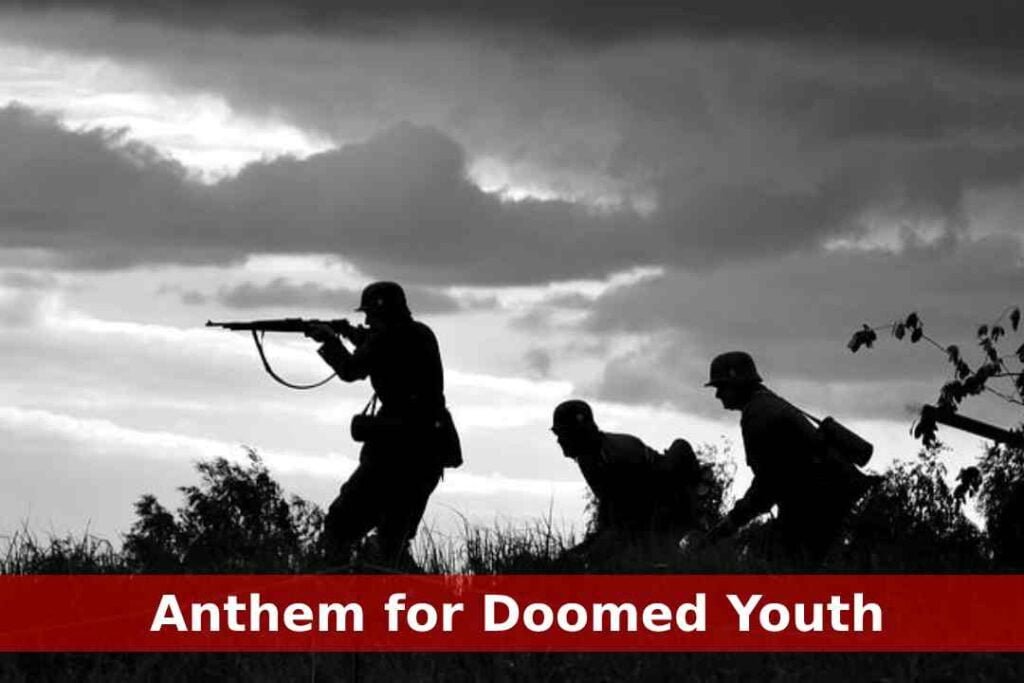About the Poem Anthem for the Doomed Youth
Table of Contents
- The famous English war poet Wilfred Owen wrote the poem/sonnet Anthem for Doomed Youth in 1917 when he was in the hospital and recovering from injuries as well as trauma resulting from his military service during Ist World War
- This sonnet is a lamentation on the death of young people/men in war. Moreover, it describes the sensory dread/terror of combat
- Anthem for Doomed Youth deals with a particular issue/problem with the official pomp as well as a ceremony that surrounds war (the poet gestures it to by the word “Anthem” in the title of the poem) arguing that (I) Church Bells (II) Prayers, as well as (III) Choirs are an inadequate or useless tribute to the horrible realities of war
- Anthem for Doomed Youth is regarded as the second most famous/popular poem of Wilfred Owen after his other poem Dulce et Decorum Est.
What passing-bells for these who die as cattle? — Only the monstrous anger of the guns. Only the stuttering rifles' rapid rattle Can patter out their hasty orisons. No mockeries now for them; no prayers nor bells; Nor any voice of mourning save the choirs,— The shrill, demented choirs of wailing shells; And bugles calling for them from sad shires. What candles may be held to speed them all? Not in the hands of boys, but in their eyes Shall shine the holy glimmers of goodbyes. The pallor of girls' brows shall be their pall; Their flowers the tenderness of patient minds, And each slow dusk a drawing-down of blinds.
Anthem for Doomed Youth Summary
The speaker of the poem Anthem for Doomed Youth asks what does the church bells mean for those young men who have been killed similar to the farm animals? They only hear the horrifying fury of firing guns. In this way, the only prayers these young men get are quick as well as the jarring rhythm of rifle fire.
Here, the speaker of this poetic work Anthem for the Doomed Youth says that they are not offered appropriate rituals in their names; if prayers or bell-ringing.
No person will be dejected/sorrowful for the young men; but the choirs – the high pitched as well as hellish noises of falling artillery. Moreover, the bulges will call for those murdered/dying young men from mournful/gloomy hometowns as well as villages.
The speaker, in Anthem for Doomed Youth further inquiries about what candles can be lit for helping such (abovementioned) young men/soldiers in their passage from life to death. In place of holding these fading lights, the eyes of these soldiers will show the faint/dim light of life. Because they say their goodbyes to the (people of) the world.
The dead soldiers of the sonnet Anthem for Doomed Youth will not be remembered for the drapes over their coffin, they will be remembered by the grief-stricken women as well as girls. Perhaps, in place of flowers, these soldiers will be honored by: (I) Peace, as well as (II) Diplomacy – by more patience in the world.
At last, the speaker of this elegiac poem says that the end of every day in this world will be a kind of ritual as well. Because, those people who live here after the end of the war, draw down their window blinds.
Anthem for Doomed Youth Major Themes
Wilfred Owen, in his Anthem for Doomed, has introduced (I) Horrors/Terrors of War (II) Suffering (III) Death as the main themes of this poem. He paints a realistic picture of the battlefield. A(ny) reader of this poem should/is expected to realize how young soldiers offer to sacrifice their lives in order to defend their (dear) country. But, the common people of their country honor their deaths.
The young people/soldiers are killed like animals in the wars. Generally, the bells ring at the funeral of the dead men, as well as prayers are also offered. But, in the case of soldiers, it does not happen. They do not have that privilege.
In place of bells as well as prayers, sounds of guns, fires, as well as shells are heard if a soldier dies on the battleground during the war. The family members of such soldiers can do nothing; they become sorrowful and start crying at the news of their deaths.
Ques: Is u003cemu003eAnthem for Doomed Youth u003c/emu003ea Petrarchan sonnet?
Ans: yes, u003cemu003eAnthem for Doomed Youth u003c/emu003eby Wilfred Owen is a Petrarchan sonnet because it is made up of an Octave as well as a Setset with the rhyme scheme of ABABCDCD EFFEGG.
Ques: What literary devices does Wilfred Owen use in his poem u003cemu003eAnthem for Doomed Youthu003c/emu003e?
Ans: u003cemu003eAnthem for Doomed Youth u003c/emu003eis rich in the case of using literary devices. The poet uses u003cstrongu003e(I)u003c/strongu003e Simile u003cstrongu003e(II)u003c/strongu003e Personification u003cstrongu003e(III)u003c/strongu003e Alliteration u003cstrongu003e(IV) u003c/strongu003eAssonance u003cstrongu003e(V) u003c/strongu003eConsonance u003cstrongu003e(VI)u003c/strongu003e Enjambment u003cstrongu003e(VII)u003c/strongu003e Imagery, and u003cstrongu003e(VIII)u003c/strongu003e Rhetorical question in this poem.
Ques: In what meter did Wilfred Owen write u003cemu003eAnthem for Doomed Youthu003c/emu003e?
Ans: u003cemu003eAnthem for Doomed Youth u003c/emu003eis a sonnet. And, generally, sonnets are composed in iambic pentameter. (That is why) Wilfred Owen also wrote his sonnet in iambic pentameter.u003cbru003e




